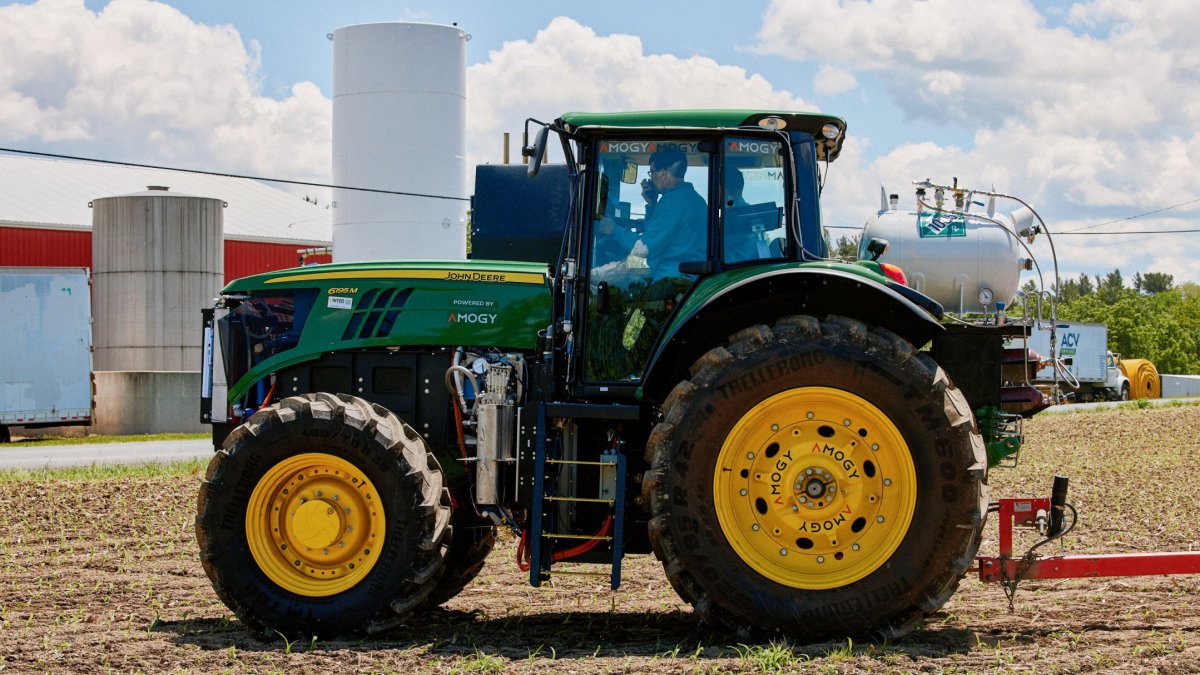Last Friday, I climbed a ladder and flopped into the seat of a bright green John Deere tractor. But there wasn’t a corn stalk or a bean sprout in sight – through the windshield I saw a fairly typical Brooklyn parking lot.
I had asked to climb onto the tractor to take a peek inside one of the few vehicles in the world that can run on a surprising fuel: ammonia. The chemical is typically used in fertilizer, but a New York-based startup called Amogy is developing technology that could power electric tractors, trucks, and even ships. I visited Amogy’s headquarters to find out why so many companies in the transport sector are looking for such new fuels and how ammonia can be used in the process.
With a share of more than 15 percent of global greenhouse gas emissions, the transport sector is an important piece of the climate puzzle. And while we’re making steady progress thanks to electric vehicles, trains and other sustainable modes of transport, there are pieces of the puzzle that are harder to solve, like vehicles that have to travel long distances or drive for long periods of time without being able to stop to charge.
Ammonia is everywhere
Amogy now believes the key to solving this problem lies in ammonia. Ammonia is one of the most transported chemicals around the world today because it is used to make fertilizers. It’s also relatively convenient, delivering a lot of power in a small space without carrying too much weight. “What’s missing from the market is how to use ammonia,” said Young Suk Jo, Amogy’s chief technology officer. “That’s what we’re developing.”
The fundamental goal behind the company’s technology is to break down ammonia into its components: hydrogen and nitrogen. The hydrogen can then be used in a fuel cell to generate electricity, while the by-product nitrogen gas is safely released into the atmosphere (which is mostly nitrogen anyway).
One of the company’s key inventions is a chemical catalyst that helps this reaction run efficiently at a lower temperature than is usual today. Amogy combines this cracker with a special control system, technology for cleaning ammonia residues from the reaction and a fuel cell. Together, all of these components can convert ammonia into electricity.
Amogy began demonstrating its system in a drone in 2021. This first system generated an average of around five kilowatts of electrical power. Next up was the tractor, which the company retrofitted with an ammonia power conversion system that is about 20 times more powerful than the old demonstration system. (The extra equipment is pretty visible on the tractor, so from where I was in the cab I had a pretty big blind spot on the right-hand side.) Finally, in January of this year, the company deployed an articulated lorry with a 300kW system a.
Off to the ship
All of these demonstration vehicles helped catch the attention of investors: the company closed a $150 million funding round earlier this year. But Amogy has bigger machines in his sights: ships.
Companies trying to reduce the climate impact of their operations in shipping are already turning to alternative fuels, including methanol and, of course, ammonia. However, Amogy’s system could be a better option than internal combustion engines because it limits emissions, which can trap heat in the atmosphere and harm human health and the environment.
I would like to note here that ammonia itself is not very pleasant to handle, it can be toxic. Proponents argue that safety protocols for handling ammonia in industry are sufficiently well established and that professionals are able to safely transport and use the chemical.
Amogy’s systems are currently not large enough for ships. The company is therefore working on another demonstrator that is intended to bring the technology closer to a commercial system: a tractor that the company plans to put into operation in New York State later this year.
Modularization planned
Eventually, the company plans to manufacture modules that can be snapped together, making the systems large enough to power ships. Amogy’s first commercial maritime system will be used by Southern Devall, which already transports ammonia on barges in the United States.
Global ammonia production exceeded around 200 million tons in 2022, most of which will be used as fertilizer. The problem is that most of it has so far been made with fossil fuels.
In order for Amogy’s systems to significantly reduce emissions, they must therefore run on ammonia, which is produced without significant greenhouse gas emissions. This is about electricity from renewable sources or at least systems that capture CO₂.
Amogy estimates the supply of these low-carbon sources of ammonia could reach about 70 million tons by 2030. However, these projects must first get past the planning stage and actually start producing ammonia before it can be used simultaneously in fertilizers, tractors or towing vehicles.

(bsc)
